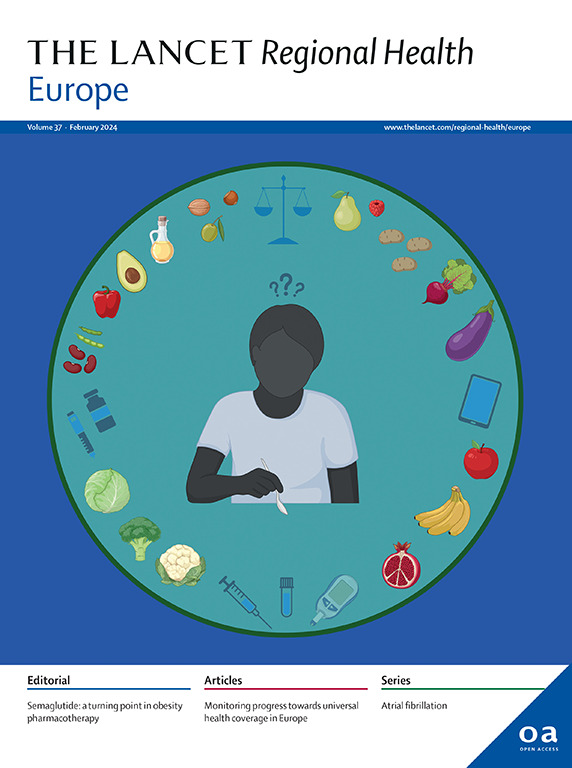曲妥珠单抗德鲁西替康与曲妥珠单抗依坦辛和图卡替尼作为her2阳性转移性乳腺癌二线和三线治疗的实际疗效和安全性:两项靶标试验模拟研究
IF 13
Q1 HEALTH CARE SCIENCES & SERVICES
引用次数: 0
摘要
背景:HER2阳性转移性乳腺癌(HER2+ mBC)的治疗迅速发展。通过模拟两项III期试验,我们评估了曲妥珠单抗德鲁替康(T-DXd)与曲妥珠单抗恩坦辛(T-DM1)和图卡替尼的实际疗效和安全性。方法采用法国国家健康数据系统模拟了两项目标试验:T-DXd与T-DM1和T-DXd与图卡替尼,用于二线和三线HER2+ mBC治疗。我们纳入了2020年9月至2023年9月的患者,并跟踪他们直到死亡或2024年4月。我们模拟了治疗加权逆概率的治疗分配随机化。疗效指标包括治疗停止时间(TTD)和总生存期(OS)。安全性结果包括特定原因的住院治疗。结果在二线治疗模拟中(n = 2931: 1633 T-DM1, 1298 T-DXd), T-DXd的TTD(中位数为14⋅1 vs 6⋅5个月;加权风险比、wHR[95%置信区间,CI]、0⋅46[0⋅42-0⋅51])和OS(中位数未达到;wHR [95% CI]、0⋅66[0⋅55-0⋅80])均高于T-DM1。我们观察到T-DXd组间质性肺疾病的病例更多。在三线治疗模拟中(n = 2391: 566 tucatinib, 1825 T-DXd), T-DXd的TTD(中位数为11⋅8 vs 5⋅8个月;wHR [95% CI], 0⋅60[0⋅53-0⋅68])和OS(中位数为31⋅7 vs 26⋅6个月;wHR [95% CI], 0⋅79[0⋅69-0⋅92])均高于tucatinib。T-DXd对心脏疾病有保护作用(wHR [95% CI], 0⋅44[0⋅26-0⋅74]),对呼吸疾病有促进作用(wHR [95% CI], 1⋅72[1⋅03-2⋅89])。在这项现实世界的研究中,与临床试验结果一致,T-DXd作为二线治疗比T-DM1和图卡替尼作为三线治疗更有效。本文章由计算机程序翻译,如有差异,请以英文原文为准。
Real-world efficacy and safety of trastuzumab deruxtecan versus trastuzumab emtansine and tucatinib as second-line and third-line treatments for HER2-positive metastatic breast cancer: two target trial emulation studies
Background
The management of HER2-positive metastatic breast cancer (HER2+ mBC) has rapidly evolved. We assessed the real-world efficacy and safety of trastuzumab deruxtecan (T-DXd) versus trastuzumab emtansine (T-DM1) and tucatinib by emulating two phase III trials.
Methods
We emulated two target trials using the French National Health Data System: T-DXd versus T-DM1 and T-DXd versus tucatinib, for second- and third-line HER2+ mBC treatment. We included patients from September 2020 to September 2023, and followed them until death or April 2024. We emulated treatment assignment randomization with inverse probability of treatment weighting. Efficacy outcomes included time to treatment discontinuation (TTD) and overall survival (OS). Safety outcomes included cause-specific hospitalizations.
Findings
In the second-line treatment emulation (n = 2931: 1633 T-DM1, 1298 T-DXd), T-DXd had longer TTD (median 14⋅1 versus 6⋅5 months; weighted hazard ratio, wHR [95% confidence interval, CI], 0⋅46 [0⋅42–0⋅51]) and OS (median not reached; wHR [95% CI], 0⋅66 [0⋅55–0⋅80]) than T-DM1. We observed more cases of interstitial lung disease in the T-DXd group. In the third-line treatment emulation (n = 2391: 566 tucatinib, 1825 T-DXd), T-DXd had longer TTD (median 11⋅8 versus 5⋅8 months; wHR [95% CI], 0⋅60 [0⋅53–0⋅68]) and OS (median 31⋅7 versus 26⋅6 months; wHR [95% CI], 0⋅79 [0⋅69–0⋅92]) than tucatinib. T-DXd tended to protect from cardiac disorders (wHR [95% CI], 0⋅44 [0⋅26–0⋅74]) while enhancing respiratory disorders occurrence (wHR [95% CI], 1⋅72 [1⋅03–2⋅89]).
Interpretation
In this real-world study, T-DXd was more effective than T-DM1 as a second-line treatment and tucatinib as a third-line treatment, in line with clinical trial results.
Funding
None.
求助全文
通过发布文献求助,成功后即可免费获取论文全文。
去求助
来源期刊

Lancet Regional Health-Europe
Multiple-
CiteScore
19.90
自引率
1.40%
发文量
260
审稿时长
9 weeks
期刊介绍:
The Lancet Regional Health – Europe, a gold open access journal, is part of The Lancet's global effort to promote healthcare quality and accessibility worldwide. It focuses on advancing clinical practice and health policy in the European region to enhance health outcomes. The journal publishes high-quality original research advocating changes in clinical practice and health policy. It also includes reviews, commentaries, and opinion pieces on regional health topics, such as infection and disease prevention, healthy aging, and reducing health disparities.
 求助内容:
求助内容: 应助结果提醒方式:
应助结果提醒方式:


